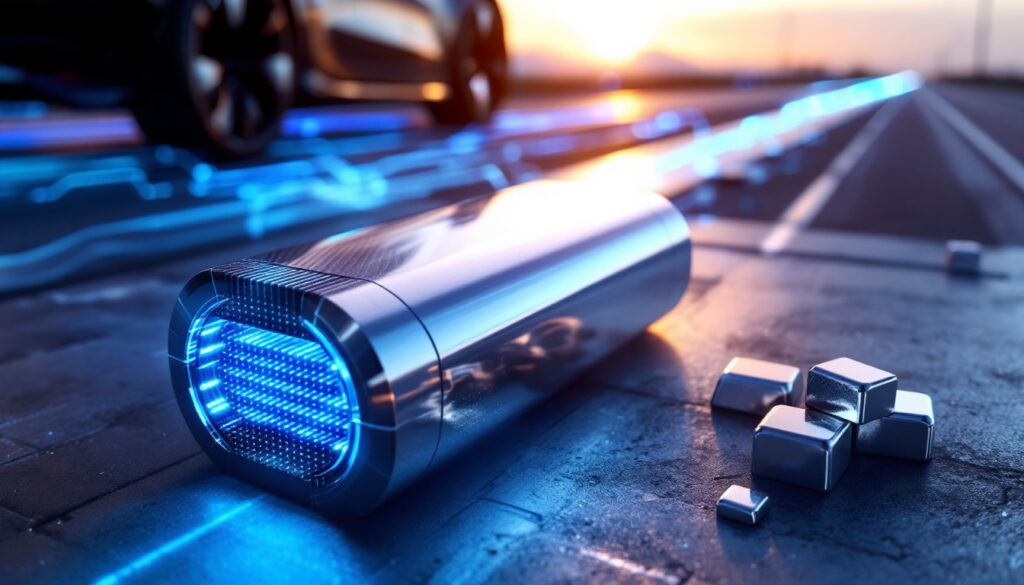What Is Samsung's Silver Solid State Battery Technology?
Understanding the Breakthrough Innovation
Samsung's solid-state battery technology marks a paradigm shift from conventional lithium-ion systems. The key innovation lies in its oxide-based solid electrolyte, which eliminates flammable liquid components, significantly enhancing safety and thermal stability. The integration of a silver-carbon (Ag-C) composite layer within the anode enables thinner electrode designs while maintaining structural integrity during charge-discharge cycles. This architecture achieves an energy density of approximately 500 Wh/kg—nearly double that of mainstream EV batteries—by optimizing ion transport pathways and minimizing internal resistance. As the battery metals boom continues to shape global markets, Samsung's innovation represents a significant leap forward.
Key Performance Advantages
The Ag-C composite anode directly contributes to the battery's exceptional metrics. By leveraging silver's high electrical conductivity and mechanical durability, Samsung has overcome traditional trade-offs between energy density and charging speed. Laboratory tests indicate that the solid-state design reduces dendrite formation, a common failure mode in lithium-ion batteries, extending cycle life to over 1,500 full charges without significant capacity degradation. These advancements address two critical barriers to EV adoption: range anxiety and charging infrastructure limitations.
How Does Silver Enhance Battery Performance?
The Technical Role of Silver in Solid State Batteries
Silver serves multiple synergistic functions in the battery's architecture. Its high electron mobility facilitates rapid charge transfer at the anode-electrolyte interface, enabling the 9-minute fast-charging capability. Additionally, the Ag-C composite acts as a buffer layer, mitigating volume expansion during lithium-ion intercalation. This stabilization is critical for maintaining electrode integrity over the battery's 20-year operational lifespan. Computational models suggest that silver's catalytic properties may also enhance the reversibility of lithium plating, further improving efficiency. Recent progress in direct lithium extraction methods complements these advancements by ensuring a sustainable supply chain.
Quantifying Silver Content in Each Battery
Each battery cell incorporates approximately 5 grams of silver, translating to 1 kilogram per 100 kWh vehicle battery pack. At current silver prices (~$1,071/kg), this adds $1,071 to material costs per vehicle. However, the extended lifespan and reduced replacement frequency offset this premium. For context, global silver production stands at 25,660 metric tons annually. If 20% of the 16 million EVs produced yearly adopted this technology, silver demand would increase by 16,000 metric tons—representing 62% of current supply. According to a recent analysis by Samsung SDI, their solid-state batteries could potentially achieve the highest energy density in the industry.
When Will Silver Solid State Batteries Enter the Market?
Accelerated Development Timeline
Samsung has compressed its commercialization timeline, with pilot lines operational since Q3 2024 and initial deliveries to luxury automakers underway. Field tests conducted in extreme temperature ranges (-30°C to 60°C) demonstrate stable performance, with less than 5% capacity loss after 500 cycles. The first production vehicles featuring this technology are slated for late 2026, targeting premium segments before trickling down to mass-market models by 2030.
Implementation Challenges and Solutions
Scaling production remains the primary hurdle. Current deposition techniques for the Ag-C layer yield 30% defect rates, necessitating advanced laser annealing processes to improve consistency. Charging infrastructure also requires upgrades to support 500 kW stations capable of delivering 900 A at 800 V. Partnerships with charging networks aim to deploy 10,000 compatible stations globally by 2027. These developments are occurring alongside broader mining decarbonisation trends that could further enhance the sustainability profile of these batteries.
Why Is This Technology a Potential Game-Changer?
Consumer Benefits Analysis
The 600-mile range eliminates daily charging needs for most drivers, while fast-charging times approximate gasoline refueling convenience. Over a 20-year period, the total cost of ownership becomes competitive with internal combustion engines, even with higher upfront costs. Safety enhancements are equally impactful: the solid electrolyte's flash point exceeds 500°C, compared to 150°C for liquid alternatives, virtually eliminating fire risks.
Environmental and Industry Impact
Lifecycle analyses indicate a 40% reduction in carbon emissions per kWh compared to conventional batteries, primarily due to extended service life and reduced cobalt content. Grid storage applications could amplify these benefits—a 1 MWh silver solid-state system provides equivalent cycle life to three lithium-ion installations. Automakers adopting this technology may gain 3–5 years of technological leadership, with patent filings covering electrode fabrication methods and recycling protocols.
What Are the Implications for Silver Markets?
Potential Silver Demand Projections
At full adoption (80% market share), EV batteries alone would consume 64,000 metric tons of silver annually—2.5 times current global production. This excludes potential demand from consumer electronics and grid storage applications. Such growth would require doubling silver mining output or developing efficient recycling systems capable of recovering 95% of battery silver. Historical analogs suggest prices could exceed $50/oz under these conditions, though substitution threats from copper-nickel composites remain a mitigating factor. Precious metals like gold and silver safe havens are gaining increased attention amid these technological developments.
Market Supply Considerations
Primary silver mines operate at 85% capacity utilization, with lead times for new projects exceeding 10 years. Recycling infrastructure currently recovers only 18% of industrial silver, highlighting the need for closed-loop systems. The technology's success may spur innovations in silver thrifting, though Samsung's patents suggest the Ag-C layer is thickness-optimized at 8–12 μm, leaving limited room for reduction. Investors are increasingly viewing silver as a strategic investment with significant upside potential due to these emerging industrial applications.
How Does This Compare to Other Battery Technologies?
Competitive Advantage Analysis
Compared to lithium iron phosphate (LFP) batteries, Samsung's technology offers 3× the energy density and 50% faster charging. Even next-generation sodium-ion alternatives trail by 40% in cycle life. The silver-based design also avoids cobalt supply chain risks, with material costs constituting 33% of the bill of materials versus 45% for nickel-manganese-cobalt (NMC) variants.
Alternative Development Paths
Samsung maintains parallel development tracks, including lithium-sulfur and solid-state polymer electrolytes. However, the silver-carbon architecture shows superior scalability, with pilot lines achieving 80% yield rates versus 35% for sulfide-based alternatives. Cross-licensing agreements with Toyota and QuantumScape suggest industry-wide recognition of its potential. The race to address critical mineral shortages remains a key factor in determining which technologies will ultimately dominate the market.
What Other Applications Could Benefit from This Technology?
Beyond Electric Vehicles
Aerospace applications stand to gain significantly—the battery's 500 Wh/kg density enables electric aircraft with 500-mile ranges. In consumer electronics, smartphone prototypes demonstrate 48-hour battery life with 5-minute charging. Grid-scale implementations show promise for solar load-shifting, with 90% round-trip efficiency compared to 85% for flow batteries.
Technical Adaptation Challenges
Miniaturization for wearables requires novel vapor deposition techniques to apply 5 nm Ag-C layers. Marine applications face saltwater corrosion challenges, though accelerated testing shows the solid electrolyte resists chloride penetration 10× better than liquid counterparts.
What Questions Remain About This Technology?
Technical Uncertainties
Long-term cycle data beyond 2,000 charges remains unpublished. Thermal management in high-current applications (e.g., trucks) requires validation, as does cold-weather performance below -40°C. Silver's price volatility introduces supply chain risks—a 50% cost increase would raise battery prices by 15%, potentially slowing adoption.
Market Adoption Questions
Consumer willingness to pay a $5,000–$10,000 premium for solid-state benefits remains untested. Regulatory approvals, particularly UN38.3 safety certification, could delay launches by 6–18 months. Competing standards for ultra-fast charging infrastructure may fragment the market, complicating interoperability.
FAQs About Samsung's Silver Solid State Battery
How Does the Silver Content Affect Battery Cost?
While silver adds $1,071 per vehicle at current prices, the 20-year lifespan distributes this cost at $53.55 annually—far below the $200/year average for lithium-ion replacements. Total cost parity with internal combustion engines is projected by 2035 as recycling economies mature.
Will Silver Supply Constraints Limit Production?
Short-term bottlenecks are likely, but substitution effects may alleviate pressure. Each 10% increase in silver prices reduces demand elasticity by 2.3%, incentivizing thrifting. Seabed mining concessions in the Clarion-Clipperton Zone could add 5,000 metric tons annually by 2030.
How Does Charging Infrastructure Need to Evolve?
Existing 350 kW stations must upgrade cable cooling systems to handle 500 kW throughput. Grid connections require reinforcement to 2 MW per station, comparable to small data centers. Solar-canopy integration shows promise for offsetting 30% of energy demand.
Are There Environmental Benefits Beyond Extended Range?
The technology reduces rare earth dependency by 90% compared to permanent magnet motors. End-of-life recycling potential exceeds 95% for silver versus 60% for lithium, supporting circular economy goals.
Could This Technology Be Adapted for Home Energy Storage?
Residential prototypes demonstrate 24-hour backup capacity with 10 kWh units, though current costs of $15,000/system limit appeal. Subsidy programs akin to solar tax credits could drive adoption, particularly in regions with time-of-use pricing.
Ready to Capitalise on the Next Battery Technology Breakthrough?
Discover investment opportunities in emerging battery technologies with real-time alerts from Discovery Alert's proprietary Discovery IQ model, which delivers immediate notifications on ASX-listed companies working on innovations like Samsung's solid-state battery technology. Explore how significant technological breakthroughs translate into exceptional market returns by visiting the Discovery Alert discoveries page.




